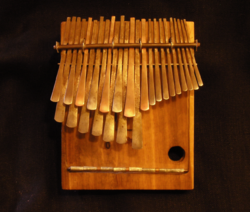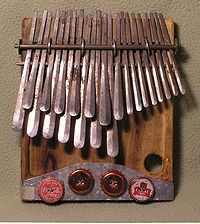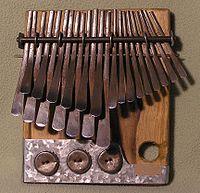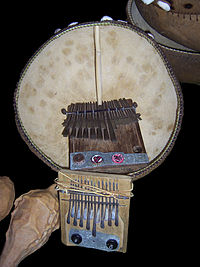- Mbira
-
Mbira or Sanza 
Mbira dzavadzimuOther instrument Classification Lamellophone, Plucked Idiophone Hornbostel–Sachs classification 122.1
(Plucked idiophone)Playing range Varies, see Tuning More articles Mbira music In African music, the mbira (also known as Likembe, Mbila, Thumb piano, Mbira Huru, Mbira Njari, Mbira Nyunga Nyunga, Karimbao or Kalimba) is a musical instrument that consists of a wooden board to which staggered metal keys have been attached. It is often fitted into a resonator. In Eastern and Southern Africa there are many kinds of mbira, usually accompanied by the hosho. Among the Shona people there are three that are very popular (see Shona music). The Mbira is usually classified as part of the lamellaphone family. It is also part of the idiophones family of musical instruments. In some places it is also known as a sanza or sansa.
In the late 1960s to early 70s sanza was the generic term used to describe these members of the lamellophone family. Mbira has now become so well known due to the worldwide stage performance and recordings of Thomas Mapfumo whose music is based on and includes the mbira, and the work of Dumisani Maraire who brought marimba and karimba music to the US Pacific Northwest, Ephat Mujuru who was one of the pioneer teachers of mbira in the US, and the writings and recordings of Zimbabwean musicians made by Paul Berliner. Mbira has now replaced sanza as the generic term. Dr. Joseph H. Howard, owner of the largest collection of drums and ancillary folk instruments in the Americas, often stated it is "the instrument most typical of Africa." By this he meant that the instruments were only found in areas populated by Africans or their descendants. Babatunde Olatunji made a similar statement in his book "Musical Instruments of Africa." He states the mbira "a finger xylophone, is native to Africa and is common throughout the continent. It is known nowhere else except in parts of the Americas where it was taken by Africans."
Contents
Mbira Dzavadzimu
Main article: Mbira music Mbira dzavadzimu in a deze.
Mbira dzavadzimu in a deze.
In Shona music, the mbira dzavadzimu ("voice of the ancestors", national instrument of Zimbabwe[1]) is a musical instrument that has been played by the Shona people of Zimbabwe for thousands of years. The mbira dzavadzimu is frequently played at religious ceremonies and social gatherings called mabira (sing. "bira").
A typical mbira dzavadzimu consists of between 22 and 28 keys constructed from hot- or cold-forged metal affixed to a hardwood soundboard (gwariva) in three different registers—two on the left, one on the right.
While playing, the little finger of the right hand is placed through a hole in the bottom right corner of the soundboard, stabilizing the instrument and leaving thumb and index finger of the right hand open to stroke the keys in the right register from above and below. The fingers of the left hand stabilize the left side of the instrument, with most fingers reaching behind the instrument. Both registers on the left side of the instrument are played with the left thumb and sometimes the left forefinger.
Bottle caps, shells, or other objects ("machachara"[2]) are often affixed to the soundboard to create a buzzing sound when the instrument is played. In a traditional setting, this sound is considered extremely important, as it is believed to attract the ancestral spirits.
During a public performance, an mbira dzavadzimu is frequently placed in a deze (calabash resonator) to amplify its sound.
The mbira dza vadzimu is very significant in Shona religion and culture, considered a sacred instrument by natives. It is usually played to facilitate communication with ancestral spirits. Within the Shona tradition, the mbira may be played with paired performers in which the kushaura, the caller, leads the performed piece as the kutsinhira, the responder, "interlocks" a subsequent part.[3]
Tuning
Tunings vary from family to family, referring to relative interval relationships and not to absolute pitches. The most common tuning is Nyamaropa, similar to the western Mixolydian mode. Names may also vary between different families. For example, Garikayi Tirikoti has developed a "mbira orchestra" that has seven different tunings, each starting on a different interval of the same seven-note scale, where it is possible to play all instruments in a single performance. The seven tunings that Garikayi uses are: Bangiza, Nyabango, Nhemamusasa, Chakwi, Taireva, Mahororo, and Mavembe (all of which are also names of traditional songs save for Mavembe and Nyabango). The closest to what is commonly named "Nyamaropa" is his "Nhemamusasa" tuning.
Historically, mbira tunings have not mapped exactly onto Western scales; it is not unusual for a seven-note sequence on a mbira to be "stretched" over a greater range of frequencies than a Western octave and for the intervals between notes to be different from those in a Western scale. Tunings have often been idiosyncratic with variations over time and from one player to another. A mbira key produces a rich complex of overtones that varies from one instrument to another depending on its maker's intentions and accidents of fabrication, such that some instruments simply sound better when some notes of a familiar tuning are pushed. With the increased popularity of the mbira in North America, Europe, and Japan in recent decades, Zimbabwean mbira makers have tended to tune their instruments more uniformly for export, but much variation is still found among mbira in their homeland.
Common names for tunings are
- Dambatsoko (Ionian mode), played by the Mujuru family. The name refers to their ancestral burial grounds.
- Dongonda, usually a Nyamaropa tuned mbira with the right side notes the same octave as the left (an octave lower than usual).
- Katsanzaira (Dorian mode), the highest pitch of the traditional mbira tunings. The name means "the gentle rain before the storm hits".
- Mavembe (also: Gandanga) (Phrygian mode), Sekuru Gora claims to have invented this tuning at a funeral ceremony. The mourners were singing a familiar song with an unfamiliar melody and he went outside the hut and tuned his mbira to match the vocal lines. Other mbira players dispute that he invented it.
- Nemakonde (Phrygian mode), same musical relationship as the mavembe, but the nemakonde tuning is a very low pitched version.
- Saungweme (flattened whole tone, approaching 7 tone equal temperament).
Mbira Nyunga Nyunga
Jeke (Jack) Tapera introduced the Mbira Nyunga Nyunga in the 1960s from Tete province of Mozambique to Kwanongoma College of African music (now United College of Music) in Bulawayo. Two keys were then added to make fifteen (Chirimumimba, 2007), in two rows. The mbira nyunga nyunga is similar in construction to the Mbira Dzavadzimu, but has no hole in the soundboard. Key pitch radiates out from the center, rather than from left to right.
Zimbabwe's Dumisani Maraire originated mbira nyunga nyunga number notation. The upper row keys (from left) are keys 2, 4, 6, 8, 10, 12, and 14 while the bottom row keys are notated as 1, 3, 5, 7, 9, 11, 13, and 15. Maraire brought awareness of this instrument to the United States when he came to the University of Washington as a visiting artist from 1968-1972.
Recently a Midlands State University (Gweru, Zimbabwe) lecturer in the department of music and musicology has suggested a letter notation; the upper keys as (from first left upper key) E, D, C, F, C, D, and E and the lower or bottom keys as (from the first lower key) A, G, F, A, F, C, D, and E. But the Maraire number notation has remained the internationally accepted system (Chirimumimba, 2007).
Mark Holdaway of Kalimba Magic has introduced a graphic form of tablature for the karimba, and traditional karimba tunes as well as modern songs and new compositions and exercises are available in this tablature.
Traditional Zimbabwean Mbira Masters
- Ephat Mujuru
- Cosmas Magaya
- Sekuru Gora
- Matemai
- Forward Kwenda
- Garikayi Tirikoti
- Mbira dzeNharira
- Mhuri yekwaRwizi
- Musekiwa Chingodza
- Stella Chiweshe
- Chartwell Dutiro
- Mhuri yekwaMuchena
- Dumisani and Chiwoniso Maraire
- Jimmy Chifamba and Cypren Vambe
- Nyamasvisva and Mawungira eNharira
Other Mbira players
- Erica Azim
- Chris Berry
- Imogen Heap
- Glenn Kotche of Wilco
- Lulendo
- Jamie Muir of King Crimson
- Konono No.1
- Trent Reznor of Nine Inch Nails
- Mal Webb
- Maurice White of Earth, Wind, & Fire
- Tinashé
- Steve Hackett
- Rumbidzai Chipendo
- Okay Machisa
- Tendai Muparutsa
- Felix Simba Machiridza Gudo Guru
- Malvern Potwayo Yotinhira Arts
- Taku Mafika Mob Entertainment
- War Musambasi Yotinhira Arts
- Fidelis Mherembi Yotinhira Arts
- [[Ticha Muzav
- Emily Bryant of The Beautiful Word
- Ticha Muzavazi
- Spencer Muzipasi (Zim Afrostics)
Recordings
- Nonesuch Explorer Series 79703-2, Zimbabwe: The African Mbira: Music of the Shona People (2002). Liner notes by Robert Garfias (1971).
- Nonesuch Explorer Series 79704 Zimbabwe: The Soul of Mbira: Traditions of the Shona People (1973). Produced by Paul Berliner
- Konono N°1 Congotronics (2004). See also the corresponding Amazon listing. Contemporary recording of traditional Congolese sanza mbira (i.e. likembe) from Kinshasa, played with [diy] amplification, and gained the attention of the western world music press in 2005.
- Musical instruments 2: (LP) Reeds (Mbira). (1972) The Music of Africa series. 1 LP disc. 33⅓ rpm. mono. 12 in. Recorded by Hugh Tracey. Kaleidophone, KMA 2.
- Mbira Music of Rhodesia, Performed by Abram Dumisani Maraire. (1972). Seattle: University of Washington Press, Ethnic Music Series. Garfias, R. (Ed.). 1 LP disc. 33⅓ rpm. mono. 12 in. UWP-1001. This disc features Maraire exclusively on Nyunga Nyunga mbira. A 12-page booklet by Maraire is included, describing the background, composition, and performance of nyunga-nyunga mbira music.
- A mbira was played by Jamie Muir in the introduction of King Crimson's "Larks' Tongues in Aspic Part One"
- Penguin Cafe Orchestra used an mbira in a cover of the traditional "Nhemamusasa" titled as "Cutting Branches For a Temporary Shelter" which is the English translation.
- Njuzu Mbira: Traditional Music of Zimbabwe (30. May 2003) released by Njuzu Mbira / CD Baby
- Stella Chiweshe: Through Mbira (16. November 2009) release by Anhrefn Records / Cadiz
- Stella Chiweshe: Talking Mbira (11. June 2002) released by Piranha / Zebralution
- Tinashe Chidanyika: Sounds of the African Mbira(1. January 2009) released by ARCMUSIC / RoyaltyShare
- Mawungira eNharira:Chinamanenji(2006)released by Record & Tape Promotions (RTP) / CD and Cassette
- Mawungira eNharira:Ndodyiwa Nemakava(May 2010)released by Gramma Records / CD
See also
- Electric lamellophone
- Music of Africa
- Polyrhythm
- Kalimba
- Gravikord
Notes
- ^ "Music in Zimbabwe". Nordiska Afrikainstitutet. March 16, 2006. Archived from the original on December 26, 2007. http://web.archive.org/web/20071226003847/http://www.nai.uu.se/research/areas/cultural_images_in_and_of/zimbabwe/music/. Retrieved December 17, 2007. "The instrument is, in slightly varying forms, several centuries old and is found in many parts of Africa, but only in Zimbabwe has it risen to become something of a national instrument"
- ^ Williams, B. Michael. (2001) Learning Mbira: A Beginning. Everett, PA: HoneyRock. ISBN 0-9634060-4-3
- ^ Berliner 1978:73
References
- Warner Dietz, Betty and Olatunji, Michael Babatunde. (1965). Musical Instruments of Africa: Their Nature, Use, and Place in The Life of a Deeply Musical People. New York: John Day Company.
- Howard, Joseph H. (1967). Drums in the Americas. New York: Oak Publications.
- Mutwa, Credo Vusa'mazulu. (1969). My people: the incredible writings of Credo Vusa'mazulu Mutwa. Johannesburg : Blue Crane Books, 1969.
- Tracey, Andrew. (1970). The Matepe Mbira Music of Rhodesia. Journal of the African Music Society, IV: 4, 37-61. (Note: this article is the original source of the Matepe song Siti, as played by Zimbabwean Marimba band Musango.)
- Tracey, Hugh. (1961). The evolution of African music and its function in the present day. Johannesburg: Institute for the Study of Man in Africa.
- Tracey, Hugh. (1969). The Mbira class of African Instruments in Rhodesia (1932). African Music Society Journal, 4:3, 78-95.
- Paul Berliner (1978), The soul of Mbira. Berkeley: University of California Press.
External links
- The Mbira Page, Solomon Murungu's Shona music site
- Tinotenda An introduction and guide to the mbira and mbira music
- Mbira players list, from N. Scott Robinson site
- The Mbira Oracle The Mbira Oracle Instructional web channel posting videos for Mbira dzaVadzimu.
- Dandemutande, non-profit organization devoted to Shona music
- MBIRA, non-profit organization devoted to Shona mbira music directed by Erica Azim and based in Berkeley, California
- Serevende, Zimbabwean mbira centre in Belgium
- Mhumhi Records, non-profit record company devoted to Shona music
- Zimbabwean Music Festival (Zimfest), annual Zimbabwean music festival in North America
- http://www.music.vt.edu/musicdictionary/textm/Mbira.html
- Mbira article by N. Scott Robinson
- Mbira tunings page, by N. Scott Robinson
- Thesis paper on improvisation on Mbira dzaVadzimu by Adrian Wagner
- Measurements of the Acoustics of the Kalimba from the Journal of the Acoustical Society of America
- Yeshe, German-born Australian mbira players
- Adamaduma, an Afro-Yemen-Canaanite Fusion Ensemble, With mbira as a main melodic instrument
- Imogen Heap, a London singer-songwriter pop star, with an array mbira commonly accompanying a piano.
- Award Winning Zimbabwean Mbira Music and Cultural Ensemble
- Information on forthcoming Mbira music projects and shows round the globe
Categories:- Lamellophones
- African musical instruments
- Zimbabwean musical instruments
- Equatoguinean musical instruments
Wikimedia Foundation. 2010.




